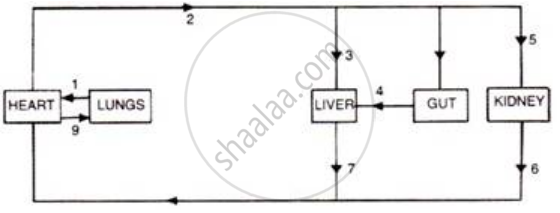Advertisements
Advertisements
प्रश्न
The figures given below are cross-sections of blood vessels.
(i) Identify the blood vessels A, B, and C.
(ii) Name the parts labeled 1-4.
(iii) Mention two structural differences between A and B.
(iv) Name the type of blood A that flows (a) through A, (b) through B.
(v) In which of the above vessels referred to in (iv) above does exchange of gases actually take place?
उत्तर
(i)
(A) Artery
(B) Vein
(C) Capillary.
(ii)
1. Connective tissue
2. Lumen.
3. Tunica media.
4. Tunica intima/Endothelium.
(iii) Two structural differences between arteries and veins are :
(a) Arteries are thick-walled and veins are thin walled.
(b) There are no valves in arteries while valves are present in veins.
(iv) (a) Oxygenated blood flows through A.
(b) Deoxygenated blood flows through B.
(v) The exchange of gases takes place in C capillaries.
APPEARS IN
संबंधित प्रश्न
Which one of the following does not have valves?
Fill in the blank with suitable word given below:
The _________ artery takes the blood from the ventricles to the lungs.
Fill in the blank.
The red-coloured pigment present in RBCs is called __________.
Describe the functions of Blood.
Name the iron containing protein present in RBC of blood.
The following simplified diagram refers to the outline plan of the circulation of blood in a mammal. Study the diagram and write the number and name of the blood vessel in each case as mentioned ahead.

Which vessel would contain the highest concentration of amino acids and glucose soon after a meal?
Name the Following
The blood vessel that begins and ends in capillaries.
Name the Following
The fine blood vessels in the tissues through which exchange of materials occurs
Complete the following sentence with appropriate word:
The blood vessel leaving the left ventricle of the mammalian heart is the _________.
Why can you feel a pulse when you keep a finger on the wrist or neck but not when you keep them on a vein?
